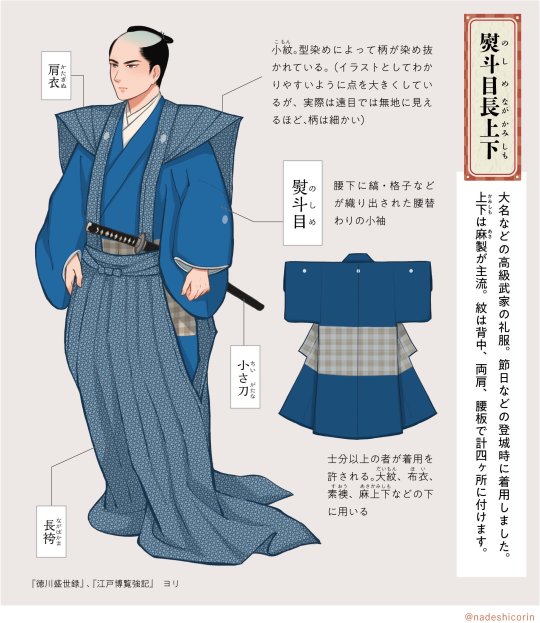#nagakamishimo
Text


Samurai's ranks and dress code in Late Edo period
AMAZING reference chart put together by Nadeshico Rin, showing the different attires worn by the men of the buke class in and about Edo Castle. OP stresses the chart is by no means exhaustive - but it helps picturing things SO MUCH!
For easier reading, I have adapted the chart with english translation. Rin has also created illustrations detailing each attire, I'll translate those in coming days under the tag "samurai kimono".
You'll find the transliteration below cut:
The court ranks - Mibun 身分 or Ikai (位階)
Find more about the exact titles here.
一位 Ichii (First court rank)
三位 Sanmi (Third court rank) and 四位 Shii (Fourth court rank)
Goi 五位 (Fifth court rank)
Omemie ijô 御目見 以上, the "upper" vassals allowed to request audience with the shogun
Omemie ika 御目見 以下, the "lesser" vassals (not allowed to request audience with the shogun)
Rin does not mention the second court rank (二位 Nii) so I am not sure where this one is supposed to go ^^;
The clan/families - Kamei 家名
徳川将軍家 Tokugawa shôgunke (Tokugawa Shogun clan)
尾張徳川家 Owari Tokugawake (Owari Tokugawa clan), 紀伊徳川家 Kii Tokugawake (Kii Tokugawa clan), 水戸徳川家 Mito Tokugawake (Mito Tokugawa clan), 徳川御三卿 Tokugawa gosankyo (Secondary Tokugawa branch clans: Tayasu, Shimizu, and Hitotsubashi)
三奉行 Sanbugyô, & 下三奉行 Shimosan bugyô (magistrates, governors)
旗本 Hatamoto (general term for upper-rank vassals of the Tokugawa)
御家人 Gokenin (general term for lower-rank vassals of the Tokugawa)
Outfits TPO (Time, Place, Occasion)
第一礼服 (大礼 など) Daiichi raifuku (tairei nado) - Most formal outfit worn during State/important ceremonies, etc.
礼服 (正月など) Raifuku (Shogatsu nado) - Formal outfit, worn for events like New Year, etc.
通常礼服 (節句など) Tsûjô raifuku (sekku nado) - Regular
formal outfit, worn during seasonal festivals, etc.
平服 Heifuku - Everyday outfit
Type of outfits
Rin has released separated charts detailing the different costumes. You'll find them translated here in coming days.
束帯 Sokutai - old ceremonial court dress, first worn by Heian nobility. Attire includes the 笏 shaku (flat ritual sceptre), and 冠 kanmuri hat.
衣冠 Ikan - old ceremonial court dress, much more simpler than sokutai
布衣 Hoi - "plain" 狩衣 kariginu (which were informal clothes worn by the nobility from the Heian period and onwards)
素襖 Suô - ceremonial dress of the lower-ranked samurai
直垂 Hitatare - ceremonial court robe
狩衣 Kariginu - patterned kariginu (informal clothes worn by the nobility from the Heian period and onwards)
大紋 Daimon - 直垂 hitatare with large family crests
直衣 Nôshi - everyday robes which were first worn by males of the imperial family during Heian era, and then spread among nobility, etc.
長上下 Naga Kamishimo - outfit pairing a sleeveless ceremonial robe called 肩衣 kataginu, with trailing pants called 長袴 nagabakama
半上下 Han Kamishimo - outfit pairing a sleeveless ceremonial robe called 肩衣 kataginu, with ankle lenght pants called 半袴 hanbakama
#japan#history#fashion history#samurai kimono#samurai#nadeshico rin#edo era#edo period#shogun#tokugawa#ressources#references#Sokutai#Ikan#Hoi#Suo#Hitatare#Kariginu#Daimon#Noshi#Kamishimo#nagakamishimo#hankamishimo#kataginu#hakama#nagabakama#hanbakama#court rank#buke#warrior class
758 notes
·
View notes
Text
Everyday wear for the warrior class - Nagakamishimo and Hankamishimo
(as worn by samurai of the Edo period - great charts by Nadeshico Rin). You can find more about samurai ranks and their regulated attires under the tag "samurai kimono".
The Nagakamishimo (here with noshime)

長上下 Nagakamishimo was worn by all upper ranked samurai.
肩衣 Kataginu - sleeveless overvest, with startched shoulders. It bore back and shoulder 紋 mon (family crests).
It's said to be an evolution of 素襖 Suô attire with detached sleeves.
Formal ones were also entirely covered with tiny dyed patterns, the 小紋 komon (clans tended to have their favourite ones, used by all their retainers).
長袴 Nagabakama - hakama pants with long trailing legs.
Formal look required it to match the kataginu.
熨斗目 Noshime - kosode (=ancestor of the kimono) with stripes or lattice pattern at waist area. Note the mon family crest on the sleeves and back.
Noshime was also worn under more formal sets, like the daimon, suô, hoi, etc.
小さ刀 Chîsagatana - small katana
The Hankamishimo

Also called 継上下 tsugi-gamishimo, 半上下 hankamishimo is the official everyday wear for all Edo period samurai.
Main difference with nagakamishimo are the shorter pants, far more suited to everyday life. Colors and fabrics were not especially regulated.
半袴 Hanbakama - ankle lenght pants, shorter than the more formal nagabakama. Today, it's simply called hakama.
脇差 Wakizashi - short sword worn by samurai, depending on the era is part of the 大小 daishô (sword set with a katana and wakizashi)
紋付小袖 Montsuki-kosode - kosode (=ancestor of the kimono) adorned with family crest
#japan#fashion#fashion history#samurai fashion#nadeshico rin#edo period#samurai#buke#warrior class#edo era#reference#ressources#men kimono#着物#Nagakamishimo#Hankamishimo#kataginu#nagabakama#noshime#Chîsagatana#hanbakama#wakizashi#daishô#Montsuki-kosode#kosode
174 notes
·
View notes